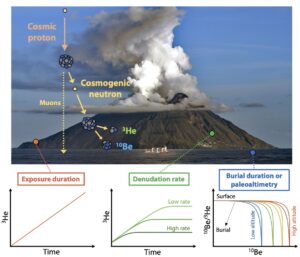Blard, Pierre-Henri, Chemical Geology (2021) Chemical Geology, 2021, 586, 120543
`Voir en ligne : https://doi.org/10.1016/j.chemgeo.2021.120543

Abstract :
This review article summarizes the state of the art of cosmogenic 3He (3Hec), with a focus on the most efficient methods and strategies for measuring this cosmogenic noble gas in the terrestrial minerals. Our ability to accurately and precisely measure cosmogenic 3He in minerals is mainly constrained by the level of the noncosmogenic 3He background (i.e., magmatic, radiogenic, nucleogenic, and atmospheric 3He), and thus by the geological characteristics of the samples. Constructing 3He vs 4He isochrons by analyzing several aliquots from the same surface sample constitutes a useful and overlooked method. Isochrons can be applied to mineral samples with homogeneous radiogenic 4He concentration and variable magmatic helium concentrations. This method also allows the direct and joint determination of the cosmogenic 3He concentration and the magmatic 3He/4He ratio, precluding the often-complicated step of vacuum crushing. I perform numerical modeling to explore the impact of the non-cosmogenic 3He components on the final uncertainties and detection limits of 3Hec measurement. Reducing the magmatic component by selecting phenocrysts in the 100–500 μm size fraction improves the precision of cosmogenic 3He analyses. Moreover, it is important to measure U, Th, and Li concentrations in the analyzed minerals and their host rocks to ensure proper corrections for radiogenic 4He and nucleogenic 3He, improving both the accuracy and precision of the method. I discuss the most important aspects of analytical techniques, including the key parameters of noble gas mass spectrometry that result in accurate and precise helium isotopic measurements. I also review 3Hec production rates and their spatial variability : the global database of absolute calibration sites yields a world-wide average 3Hec production rate in olivine and pyroxene of 124 ± 11 at g-1 yr- 1 using the LSD scaling and the online CREp calculator (https://crep.otelo.univ-lorraine.fr/#/). Cross-calibrations against 10Be indicate that the ratio of the production rate of 3Hec in olivine/pyroxene to that of 10Be in quartz is 33 ± 2 and increases by less than 7% between sea level and 5000 m elevation. This important observation demonstrates that 3He in olivine/pyroxene and 10Be in quartz are accurately scaled with existing models and can hence be considered as synchronized chronometers. However, 3Hec/10Be cross-calibrations based on 3Hec in accessory minerals (zircon, garnet, kyanite, apatite) yield unexpectedly high 3He/10Be production ratios of 40–60 above 3000 m elevation. As the capture of cosmogenic thermal neutrons by 6Li is unlikely to explain this excess, other mechanisms are required, such as 3Hec inherited from previous exposure episodes, unrecognized specific reaction pathways, or the impact of snow cover. New cross-calibration data obtained by measuring 3Hec against other cosmogenic nuclides (14C, 36Cl, 21Ne, 53Mn) in different settings will advance our understanding of cosmogenic nuclide production rates and improve the accuracy and precision of applications relying on cosmogenic 3He. Other improvements could extend the applicability of the 3He geoscientific toolbox ; for example, coupling 3He with radioactive cosmogenic nuclides (10Be, 14C, 36Cl, 53Mn) will allow paleoaltimetry or the determination of burial ages or paleo-depths in intermediate and mafic terrains



